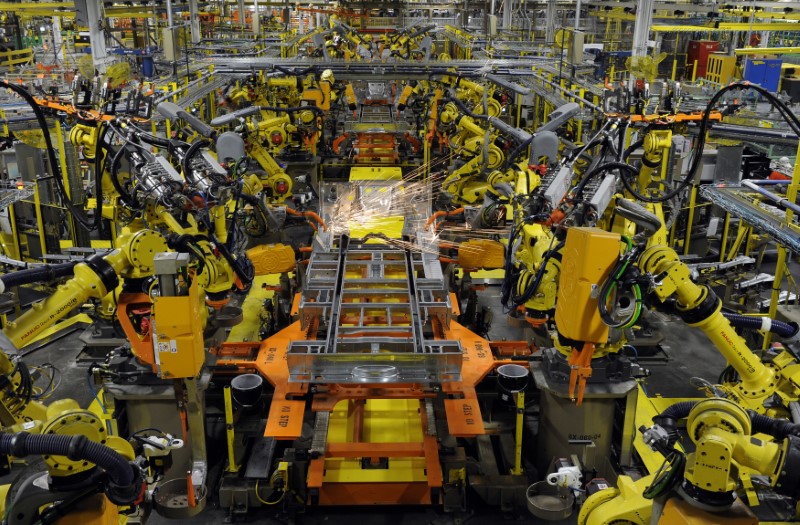By Lucia Mutikani
WASHINGTON (Reuters) - U.S. industrial production increased more than expected in December as unseasonably cold weather at the end of the month boosted demand for heating, but manufacturing output barely rose, pointing to moderate growth in the industrial sector.
Strong demand for utilities reported by the Federal Reserve on Wednesday bolstered expectations of an acceleration in consumer spending in the fourth quarter, prompting some economists to bump up their economic growth estimates for the October-December period.
"This is consistent with the solid growth story," said Jennifer Lee, a senior economist at BMO Capital Markets in Toronto.
The Fed said industrial output surged 0.9 percent last month also buoyed by robust gains in mining production, after slipping 0.1 percent in November.
Economists polled by Reuters had forecast industrial production advancing 0.4 percent in December. It rose at an annual rate of 8.2 percent in the fourth quarter, the biggest gain since the second quarter of 2010.
For all of 2017, industrial output rose 1.8 percent, the first and largest increase since 2014. In another report, the U.S. central bank said the economy continued to expand from late November through the end of 2017.
In its Beige Book report of anecdotal information on business activity collected from contacts nationwide, the Fed said "the outlook for 2018 remains optimistic for a majority of contacts across the country."
The reports were seen supportive of an interest rate increase in March from the Fed. Prices for U.S. Treasuries fell, with the yield on the interest rate sensitive two-year note hitting a nine-year high. The dollar briefly rose against a basket of currencies, but later surrendered gains.
Stocks on Wall Street were trading higher.
MODEST FACTORY OUTPUT GAIN
Manufacturing output, which accounts for more than 70 percent of industrial production, gained only 0.1 percent in December. Data for October and November was, however, revised to show factory output rising 1.5 percent and 0.3 percent respectively instead of the previously reported 1.4 percent and 0.2 percent.
Manufacturing output last month was held back by a 1.5 percent drop in the production of primary metals. Motor vehicle and parts production increased 2.0 percent.
Manufacturing production rose at a 7.0 percent rate in the fourth quarter, the biggest gain since the second quarter of 2010. It increased 1.3 percent in 2017, the largest rise since 2012.
The industrial sector is being supported by a strengthening global economy and recent dollar weakness, which is helping to make U.S. exports more competitive relative to those of the nation's main trading partners.
It is likely to be boosted by a $1.5 trillion tax cut approved by the Republican-controlled U.S. Congress and signed into law by President Donald Trump last month. A survey early this month showed an acceleration in factory activity in December, with a measure of new orders recording its best reading since January 2004.
"A positive fundamental backdrop of tax cuts, solid domestic and global demand, a weaker dollar, firmer energy prices and somewhat leaner inventories all translate into solid prospects for industrial activity in 2018," said Gregory Daco, chief U.S. economist at Oxford Economics in New York.
Mining production increased 1.6 percent in December amid a rebound in oil and gas well drilling. Utilities production accelerated 5.6 percent last month after declining 3.1 percent in November.
Bitter cold gripped a large part of the country at the end of December. The surge in utilities demand added to strong December retail sales in supporting expectations of an acceleration in consumer spending in the fourth quarter.
Forecasting firm Macroeconomic Advisers raised its fourth-quarter gross domestic product growth estimate by one-tenth of a percentage point to a 2.8 percent annualized rate. Barclays (LON:BARC) lifted its GDP growth forecast to a 3.1 percent pace from a 3.0 percent rate.
Consumer spending, which accounts for more than two-thirds of U.S. economic activity, increased at a 2.2 percent annualized rate in the third quarter. The economy grew at a 3.2 percent rate in the July-September period.
The surge in industrial production pushed up capacity utilization, a measure of how fully industries are deploying their resources, to 77.9 percent. That was the highest since February 2015 and followed a 77.2 percent rate in November.

Capacity utilization is 2 percentage points below its long-run average. Officials at the Fed tend to look at capacity use as a signal of how much "slack" remains in the economy and how much room there is for growth to accelerate before it becomes inflationary.